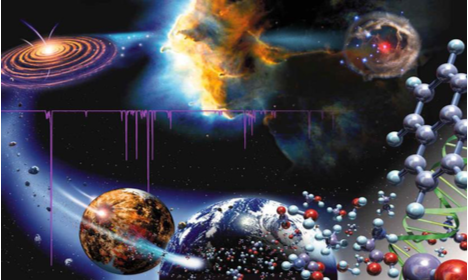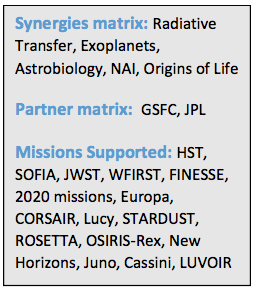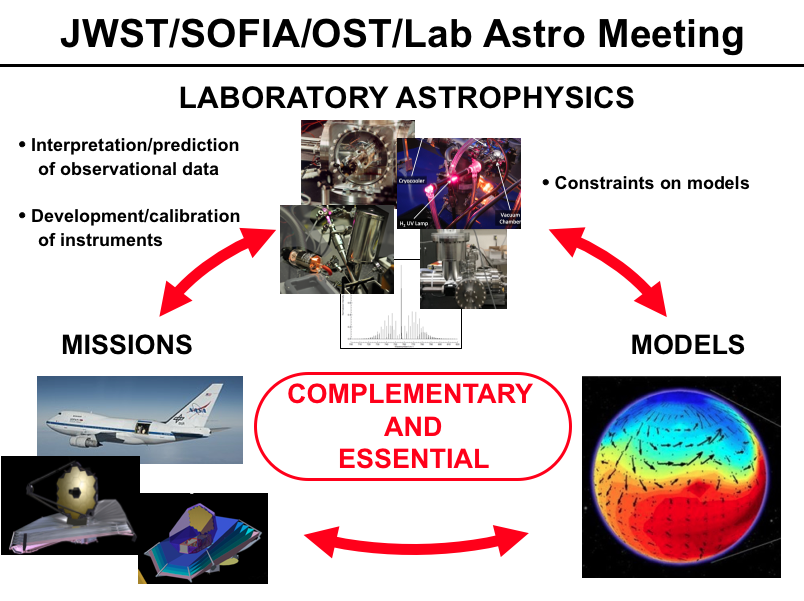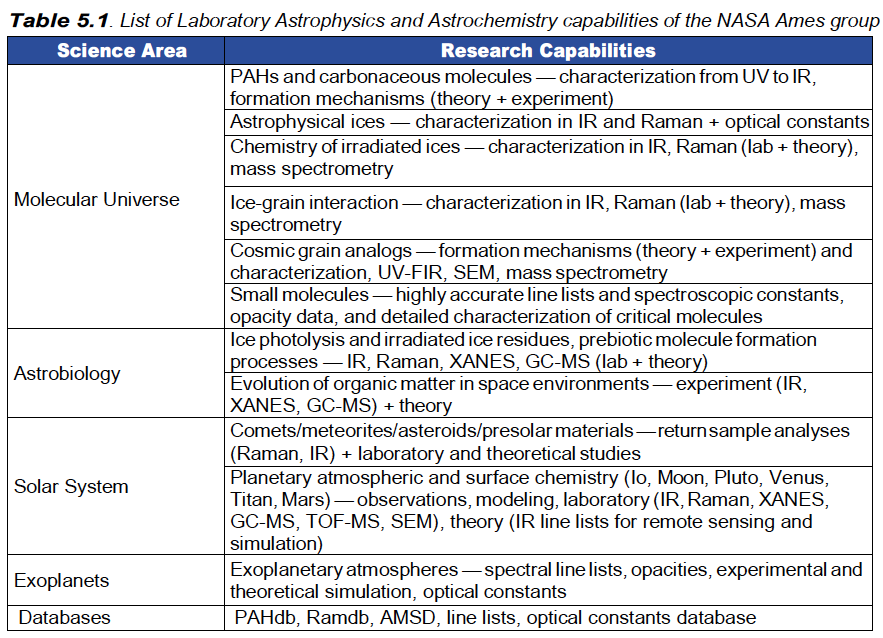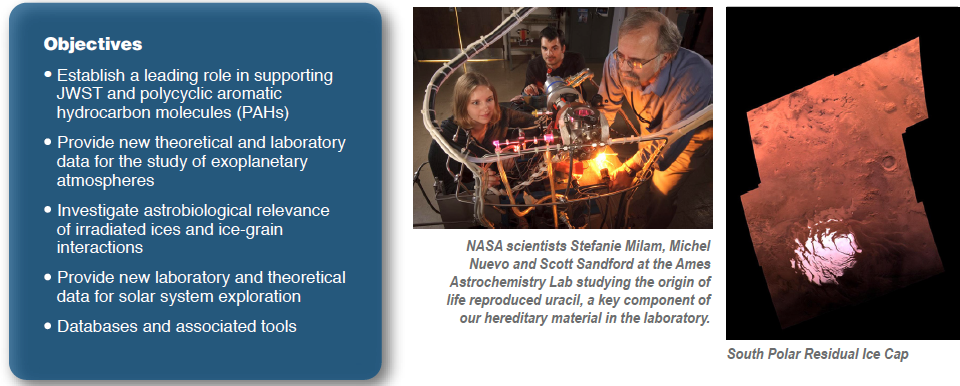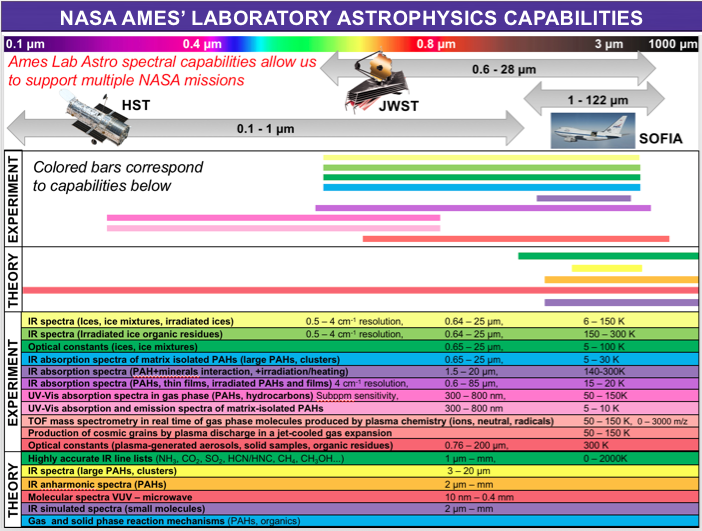Core Capability 5 – Laboratory Astrophysics and Astrochemistry
Laboratory Astrophysics and Astrochemistry Highlights
Laboratory Astrophysics plays a key and unique role in the optimization of NASA missions, both at the science conception level and at the science return level. Laboratory astrophysics is the Rosetta stone that enables the translation of space mission observations into knowledge. The field of Laboratory Astrophysics and Astrochemistry consists of laboratory experiments and theoretical calculations that are key factors for the understanding of our universe by complementing astronomical observations and modeling. Laboratory experiments and quantum calculations simulating astrophysical conditions generate data (spectra, optical constants, opacity, line lists, etc.); necessary for the interpretation of observations returned by NASA missions while providing testable predictions to advance knowledge and guide future missions. Increasingly accurate astronomical observations provide direction for Laboratory Astrophysics and Astrochemistry measurements and calculations. Hence, the interplay between observations and experimental data is a driver for new mission concepts, the development of new technologies, and mission instrumentation.
The multidisciplinary nature of the workforce at NASA Ames (astrophysicists, astrochemists, physicists, planetary scientists, theorists, astronomers) makes it a unique environment for Laboratory Astrophysics and Astrochemistry research. The expertise of the Ames Laboratory Astrophysics and Astrochemistry group, and its well-established and recognized experimental and theoretical facilities will be exploited, providing a unique capability in Molecular Universe studies (the astrophysics and astrochemistry of the interstellar medium, protoplanetary disks, etc.), Astrobiology, Solar System science, Exoplanets, and associated databases for the Agency.
The Ames Laboratory Astrophysics and Astrochemistry group will continue to be an Agency leader in providing critical data that exoplanet, planetary atmosphere and protostellar disk modelers, astronomers, and astrobiologists require to conduct their research. The Ames group will focus their laboratory efforts on the support of critical experiments and calculations, those based on the needs of the space science community.
In Table 5.1, we provide a brief listing of Laboratory Astrophysics and Astrochemistry capabilities of the Ames research group. Objectives for these applications are then provided in further detail below, including the creation and expansion of databases of experimental and theoretical data and associated research-enabling tools. This objective supports the importance of providing information to the public and better supporting the science community.
Objective 5.1 – Establish a Leading Role in Supporting JWST PAH Research
Ames researchers play a critical role in formulating major scientific advances in the understanding and study of polycyclic aromatic hydrocarbon molecules (or PAHs) and carbonaceous molecules and grains. The Ames Laboratory Astrophysics and Astrochemistry group provides spectral diagnostics, theoretical calculations, and analytical tools for species ranging from free-flying molecules to ices and dust particles present in interstellar, circumstellar and planetary environments. PAH research, in particular, has become an interdisciplinary investigation involving Ames scientists in planetary astronomy and astrophysics as well as close collaborations with other institutions, most prominently Leiden University and the Dutch Astrochemistry Network through a Space Act agreement. This research was motivated by the desire to enable the scientific community to conduct research supporting NASA projects and missions such as the KAO (initially), IRAS, ISO, Spitzer and SOFIA, and soon JWST. The Ames Laboratory Astrophysics and Astrochemistry group is currently engaging with JWST science teams and addressing their direct needs in terms of PAH research through participation in JWST Early Release Science (ERS) projects and JWST GTO collaborations, and exploration of JWST GO proposals.
A critical part of the Ames work on PAHs is the PAHdb, a comprehensive archive of thousands of laboratory-measured and quantum-chemical-computed spectra of PAHs in astrophysically relevant conditions coupled to a set of innovative astronomical models and tools. An ISFM Work Package was awarded in FY19 for NASA to actively support a stable, long-term interdisciplinary Laboratory Astrophysics and Astrochemistry effort in order to increase the content of the PAHdb spectral libraries, provide advanced tools and models, and make PAHdb the go-to tool to help the scientific community interpret the wealth of information contained in the astronomical PAH bands. PAHdb (http://www.astrochemistry.org/pahdb/) is publicly available and offers global access to over 100 high-quality experimental and over 3500 computed PAH spectra as well as innovative tools to use those data to analyze and interpret astronomical observations.
Objective 5.2 – Provide New Theoretical and Laboratory Data for the Study of Exoplanets Atmospheres
Reliable models of exoplanet atmospheres are in their infancy and have many laboratory data needs. These include highly accurate rovibrational line lists with transition intensities for stable molecules that are often found in planetary and exoplanetary atmospheres (such as H2O, CO2, SO2, NH3, CH4) and the full set of molecular spectroscopic constants for the abundant isotopologues of tracer molecules and transient species. These line lists need to be complete, consistent, and reliable for the atmosphere to be modeled. At ~500K or higher, they are often composed of hundreds of millions of lines or even more. There is a general need to combine the high-resolution experimental and ab initio quantum mechanical theoretical studies to obtain accurate rovibrational line lists for other molecules and at significantly higher temperatures and energies (for hot atmospheres). For example, laboratory data is needed for molecules such as SO2, SiO, and ZnS to allow modeling of the atmospheres of hot rocky planets. Laboratory production and measurements of such molecules and their availability to the community via an archive or database will be important as it is expected that many of the near-term exoplanet atmospheres to be observed by JWST will be of warm to hot exoplanets.
Objective 5.3 – Investigate Astrobiological Relevance of Irradiated Ices and Ice- Grain Interactions
Molecular ices are astrophysically important as they have been shown to be ubiquitous in the universe. Cold environments allow ices to condense on the surface of silicates and grains, and are dominated by simple molecules such as H2O, CH3OH, NH3, CO, CO2, and CH4. Once formed, ionizing radiation can change the structures of the ices producing new, more complex molecules. This objective will investigate photochemical processes of UV irradiation of such ices at cold, interstellar temperatures. The results of these experiments often produce astrobiological interesting complex prebiotic molecules. These organic compounds, such as amino acids and sugars, will be examined and investigated further in an attempt to determine critical steps in molecular formation resulting in macromolecules and the beginnings of life. The laboratory measurements and results from this work will be made available to the community in a public archive.
Objective 5.4 – Provide New Laboratory and Theoretical Data for Solar System Exploration
Laboratory measurements and quantum chemical calculations related to solar system objects will be continued and expanded, with past and new results made available to the community by being placed in a public database. Detailed comparison with returned extraterrestrial data/samples and new work aimed at the surface and atmospheric chemistry of small bodies in the Solar System will be conducted. Optical constants of planetary and cometary materials will be measured and disseminated to the archive as well. With a return to the Moon, optical constants associated with lunar regolith attain renewed importance in mission planning and data interpretation. In addition, laboratory work will be carried out in support of NASA sample return missions, both through work designed to support mission development and flight and to study the extraterrestrial samples returned by these missions.
Objective 5.5 – Databases and Associated Tools
Providing publicly accessible, online databases of experimental and theoretical results along with research enabling database tools represents an increasingly productive way for the Laboratory Astrophysics and Astrochemistry group to interact with and fulfill the scientific needs of the overall scientific community. At present, databases are organized by subject area. PAHdb (discussed above) provides infrared PAH spectral data and associated analysis tools. The Ames Molecular Spectroscopic Database (AMSD) plans to archive line lists and opacity data and the best available spectroscopic constants predicted for small molecules for astrophysical and atmospheric studies. In-progress efforts will provide new databases for Raman spectra and optical constants data along with associated theoretical calculations and subject-specific database tools. In a future stage of development, we intend to explore options for unifying current and future Laboratory Astrophysics and Astrochemistry databases.























